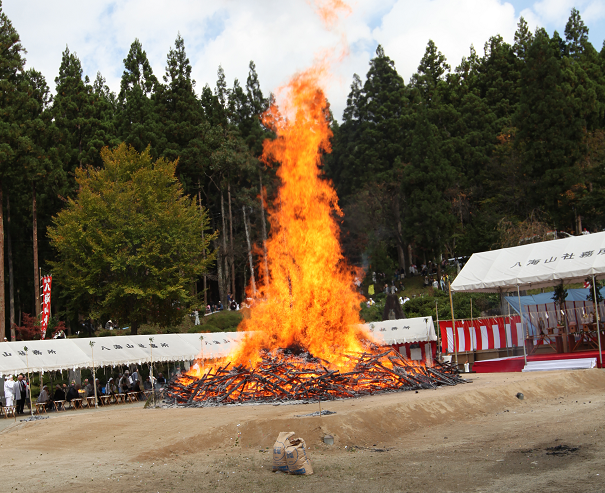 Like so many things in Japanese culture, if you explore a little bit below the surface understanding of any topic, there is a whole world to discover… this is true for sushi, kimono and of course, sake, too.
Like so many things in Japanese culture, if you explore a little bit below the surface understanding of any topic, there is a whole world to discover… this is true for sushi, kimono and of course, sake, too.
I had this same feeling when I was recently invited by the local community here in Minami Uonuma to make “New Year’s decorations”. I was envisioning something like a christmas ornament crafting session at the local community center with ribbons and glue. I arrived at the community center however to find several bundles of rice straw outside and what we would really be making started to come into clearer focus.
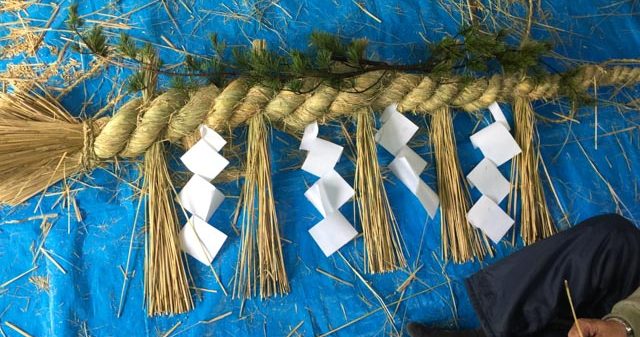
I soon understood we would be crafting our own Shimenawa (標縄) to decorate a local shinto shrine in preparation for New Years. Shimenawa is something I had seen dozens of times before, but never thought much about. It is a type of rope woven by hand out of rice straw. The ropes can range from thin to very think and they are used to delineate sacred or pure areas at a shinto shrine. These ropes are also used to signal a space that can house or enshrine a shinto deity, so you see these ropes adorning entrances to shrines and also wrapped around Yorishiro (依り代) or objects such as special trees or rocks that are capable of attracting and housing shinto gods. Our community would be working throughout the morning to create different types of Shimenawa for a small local shrine dedicated to Inari, the god of foxes, rice and sake.
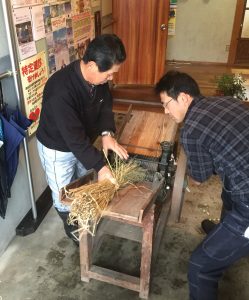 The first step in making our own Shimenawa was to soften the rice straw to make it pliable. To this end, an an old fashioned press appeared from storage. this was a machine that looked like it had seen decades of Shimenawa production. A hand crank was turned and the rice fed through to crush it a bit and soften the fibers.
The first step in making our own Shimenawa was to soften the rice straw to make it pliable. To this end, an an old fashioned press appeared from storage. this was a machine that looked like it had seen decades of Shimenawa production. A hand crank was turned and the rice fed through to crush it a bit and soften the fibers.
We all took turns running the crank and I even had a go. One of the farmers told me with out this machine we would be beating the rice with a stick to soften it. This seemed much better!
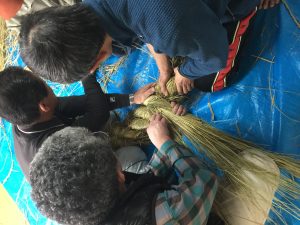 After softening, the rice was brought into the work room and everyone sat down and started working. I first just watched and was amazed to see ropes and other woven decorations begin to appear.
After softening, the rice was brought into the work room and everyone sat down and started working. I first just watched and was amazed to see ropes and other woven decorations begin to appear.
The method for making the rope boils down to rolling multiple bundles of rice straw between the palms of your hands to twist it in one direction, and then braiding the bundles in the other direction. This creates a strong rope that won’t come undone.
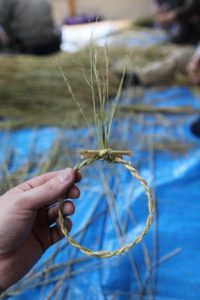 After a quick lesson, I was trying to make my own Shimenawa. My first two tries were a failure with my rope immediately unraveling, but after a bit more instruction, I figured out the trick and soon had a two ply thin rope of my own creation! I tied the rope into a circle to make a wreath.
After a quick lesson, I was trying to make my own Shimenawa. My first two tries were a failure with my rope immediately unraveling, but after a bit more instruction, I figured out the trick and soon had a two ply thin rope of my own creation! I tied the rope into a circle to make a wreath.
My next challenge was to make a kind of carrot-shaped woven decoration using a three ply rope that is hung on a shinto shrine doorframe. Working with three ply was more difficult, but I got it to work and made a smaller, messier version than the pros!
After a few hours of everyone twisting and weaving, it was time to bring all the finished products to the shrine. And the finished products were impressive. There was a large rope to hang over the entrance to the shrine and smaller ropes for the doorframe. Also, a rope was wrapped around a beautiful and huge yorishiro tree next to the shrine. The ropes were all adorned next with shide (紙垂), white zigzag paper streamers that are used to ward off evil spirits and that help demarcate a sacred space.
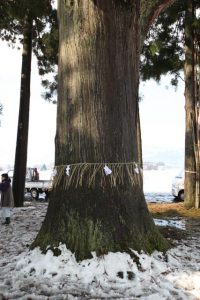
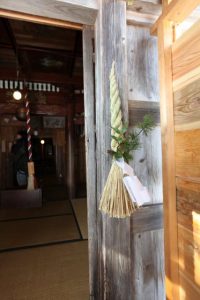
All this was done in a few hours, but I felt I had learned so much in this short time. It was such a rare experience to learn this craft first hand from Niigata locals.







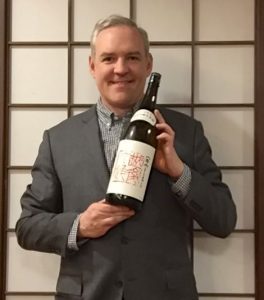 One of my favorite Japanese words that I’ve learned so far is gentei (限定), which simply means limited, but is often applied to a seasonal product or limited release product. Gentei items are popular in Japan! Hakkaisan also has some seasonal products, one of which is sold only in December each year.
One of my favorite Japanese words that I’ve learned so far is gentei (限定), which simply means limited, but is often applied to a seasonal product or limited release product. Gentei items are popular in Japan! Hakkaisan also has some seasonal products, one of which is sold only in December each year.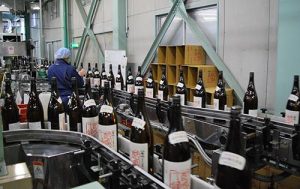
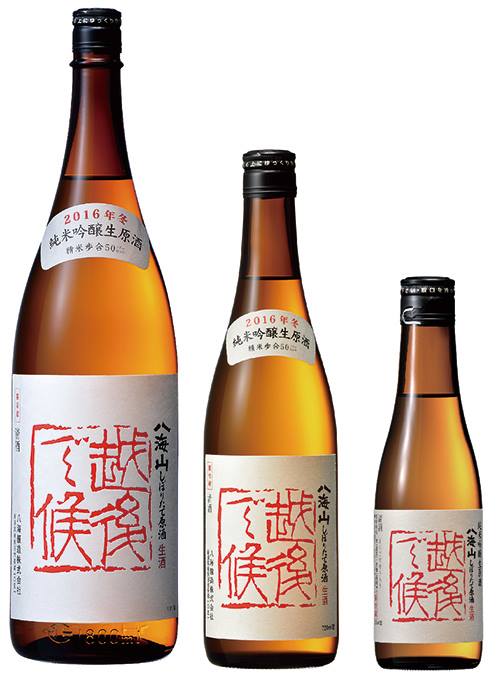
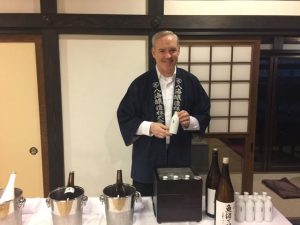 Almost every sake party or event I’ve been to in chilly Niigata has had someone assigned to be the Okanban. In short, the Okanban is the person in charge of warming sake. They make sure the sake is at the right temperature and ready when needed. At a busy event, it can be a lot to juggle, but a good Okanban keeps the sake and the party flowing!
Almost every sake party or event I’ve been to in chilly Niigata has had someone assigned to be the Okanban. In short, the Okanban is the person in charge of warming sake. They make sure the sake is at the right temperature and ready when needed. At a busy event, it can be a lot to juggle, but a good Okanban keeps the sake and the party flowing!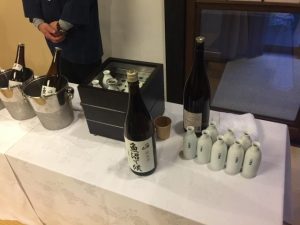 The main tool of the okanban is the shukanki. This is a metal-lined wooden box that allows you to create a hot water bath inside for the sake carafes. A dial on the outside allows you to set the water temperature. This along with a good sake thermometer are what you need to get started.
The main tool of the okanban is the shukanki. This is a metal-lined wooden box that allows you to create a hot water bath inside for the sake carafes. A dial on the outside allows you to set the water temperature. This along with a good sake thermometer are what you need to get started.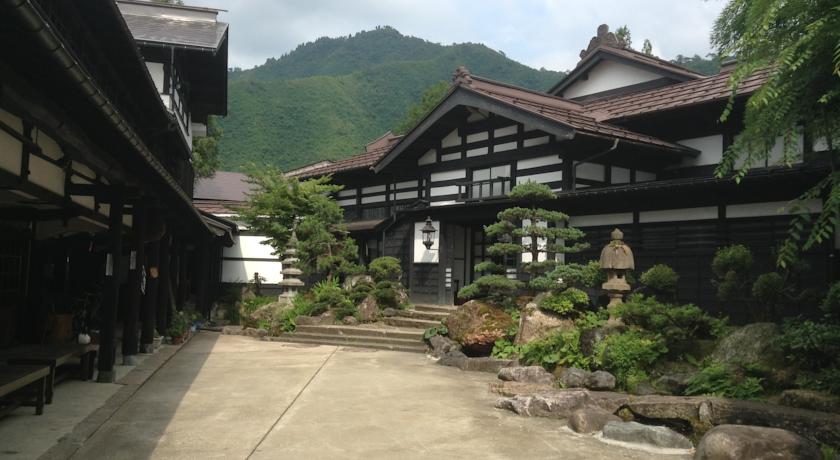
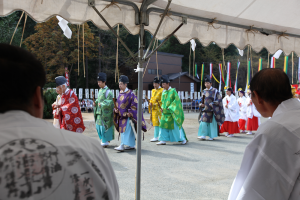 After my arrival in Niigata, I was invited to visit the nearby Hakkaisan Son Jinja Shrine to join in a festival. The god of Hakkaisan Mountain is enshrined there and worshiped by locals. It sounded like a wonderful way to spend a fall afternoon. However, I started to worry a bit when I learned the festival was called “Hiwatari taisai “ or “walking on fire” festival.
After my arrival in Niigata, I was invited to visit the nearby Hakkaisan Son Jinja Shrine to join in a festival. The god of Hakkaisan Mountain is enshrined there and worshiped by locals. It sounded like a wonderful way to spend a fall afternoon. However, I started to worry a bit when I learned the festival was called “Hiwatari taisai “ or “walking on fire” festival. 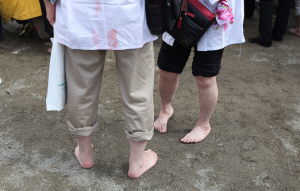 I saw many festival goers walking around barefoot in preparation for the big event. After a beautiful procession of shinto priests, dignitaries and even an ogre (oni), the fire was lit. The flames were soon so high and the heat so intense that the crowd had to move back from the fence. When I saw the huge fire and billowing smoke, I began to question the sanity of the people lining up to walk on the coals, and I took a moment to re-confirm with myself that I would not be walking. When the fire died down, two paths were raked through the coals and sprinkled with salt to temper the heat.
I saw many festival goers walking around barefoot in preparation for the big event. After a beautiful procession of shinto priests, dignitaries and even an ogre (oni), the fire was lit. The flames were soon so high and the heat so intense that the crowd had to move back from the fence. When I saw the huge fire and billowing smoke, I began to question the sanity of the people lining up to walk on the coals, and I took a moment to re-confirm with myself that I would not be walking. When the fire died down, two paths were raked through the coals and sprinkled with salt to temper the heat. 
